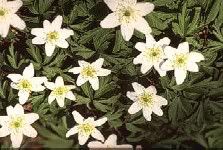

Anemone (Anemone pulsatilla) P
Folk Names: Blood-Drops-of-Christ, Cowbell, Dane Flower, Easter Flower, Herb Trinity, Little Wind Rose, Meadow Anemone, Pasque Flower, Passe Flower, Wild Crocus, Wind Flower
Description: There are some seventy species of Anemone, A. pulsatilla and A. nemorosa (covered next week) being the most prominent. Anemone are perennials, preferring dry, rocky soil. In America, they grow best on the prairie and may be found to a large extent in Illinois, Wisconsin, and Texas. The root, if it is left to grow without disturbance, is woody and can grow to great size, resembling ginger. The young rootstock has a purplish color. From the root, a rosette of finely veined and hairy leaves rises. The plant may grow anywhere from six to sixteen inches in height. The leaves are alternate, palmately dissected with narrow, linear lobes. The main characteristic of all Anemones is the whorl of three leaves appearing just under the flower. The flowers themselves have no real petals, but a calyx of six to eight petal-like purplish-blue to whitish sepals. Each appears from March to April and is solitary and terminal, appearing erect and bell-shaped. The seeds are small, brown hairy achenes with long feathery tails. The plant is ordorless but possesses a strong acrid taste which diminishes the long the dried is kept.
Effects: strong
Planet: Mars, Mercury
Element: fire
Associated Deities: Adonis, Venus
Traditions:
It is said that the scarlet anemone was created by the blood of Adonis after he was gored by a wild bore on Mt Lebanon.
It is thought that the names, Easter Flower, Pasque Flower, and Passe Flower came from its use as an Easter egg colorant. Gerard however states that the name derived from the time the plant blooms.
Magic:
An infusion of the root was used on the eyes for cross-eyes, twitching, and cataracts but it might be better to apply it symbolically rather than physically due to its poisonous qualities.
The blossoms may be gathered when first seen in spring. These should be wrapped in red cloth and worn to prevent disease. The blossoms are helpful in all healing rituals, and the roots are valuable for the healing of wounds. Red anemones may be grown in the garden to protect it and your home.
Known Combinations:
none
Medical Indications: (Caution: Anemone contains alkaloids which are most active in the fresh plant. They are highly irritating externally and internally. Externally the sap can cause blisters when applied to the skin. Internally, signs of Anemone poisoning resemble Aconite. It can cause depression, nervousness, and stomach upset and can be fatal in large quantities. Poisoning signs include a slow or feeble pulse, slow respiration, chills, and paralysis.) Parts Used : plant
The medicinal value of Anemone deteriorates the longer it is kept, and is generally of no use after a year. This is a dangerous herb, and not recommended for unskilled use. It has been used an antispasmodic, nervine, diaphoretic, and diuretic. The tincture is applied to disorders of the mucous membrane, including whooping cough, asthma, and bronchitis. It has also been applied as an emmenagogue, for relief of headaches and neuralgia. In homeopathy, it is suggested for patients suffering from measles.
Nutrition:
not edible
Mercantile Uses:
The plants are popular for use in rock gardens.